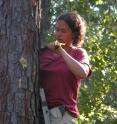Dartmouth research offers new control strategies for bipolar bark beetles
Population explosions of pine beetles, which have been decimating North American forests in recent decades, may be prevented by boosting competitor and predator beetle populations, a Dartmouth study suggests. Bark beetles are the most destructive forest pests worldwide. Management and climate change have resulted in younger, denser forests that are even more susceptible to attack. Though intensively studied for decades, until now an understanding of bark beetle population dynamics -- extreme ups and downs -- has remained elusive.
The Dartmouth-led study, published in the January issue of the journal Population Ecology, confirmed, for the first time, that the abundance of a certain animal species -- in this case the southern pine beetle -- fluctuates innately between extremes, with no middle ground.
"That is different from most species, such as deer, warblers and swallowtail butterflies, whose populations tend to be regular around some average abundance based on food, weather, and other external factors," says Matt Ayres, a professor in the Department of Biological Sciences at Dartmouth and senior author on the paper. "They don't appear and disappear in cycles. Rather, they exist in two stable equilibrium states -- one of high abundance and the other of scarcity." Once the population pendulum swings toward the high end, it won't quickly or easily swing back.
The new research by Dartmouth scientists and their forester colleagues could provide the means to limit this seemingly bipolar dynamic, keeping the bark beetles at the lower stable population level.
The studies identify the presence of bark beetle competitors and predators (specifically two other beetles) as the predominant limiting factor that can keep the bark beetles at a low, stable equilibrium. The authors suggest that the presence of these competitors and predators could be encouraged as a control strategy.
"The pine beetles produce pheromones, chemical signals, that attract enough competitors and predators to prevent outbreaks," says Sharon Martinson, a member of the research team and first author on the new paper. "Leaving more dead trees in forests can provide habitat for competitor beetles that rarely kill tree, and for predators that eat both beetle species."
The authors suggest that other pest species with catastrophic impacts may also have natural dynamics that include a tipping point between the bipolar population states. By learning what factors control those tipping points, impacts on ecosystems can be averted through monitoring and occasional intervention strategies.
Source: Dartmouth College
Other sources
- New control strategies for 'bipolar' bark beetlesfrom Science DailyFri, 25 Jan 2013, 20:00:24 UTC
- Research offers new control strategies for bipolar bark beetlesfrom PhysorgFri, 25 Jan 2013, 14:31:15 UTC
